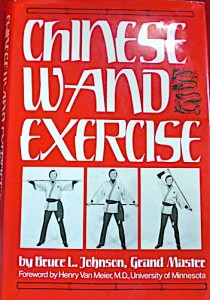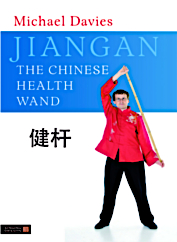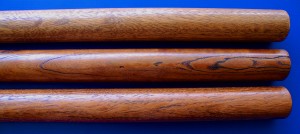 During the “Golden Era” of American Fitness from around 1885-1920, exercise “health” wands were used extensively in schools, gymnasiums, military academies, university programs, and at home. Wands can be traced back thousands of years into Chinese culture as well. Wands were actually one of the “Four Horsemen” historically which were composed of four fitness training tools: medicine balls, Indian Clubs, dumbbells, and wands. A great example of the importance significance of wands in exercise culture can be seen in our post and photos on Aaron Hewlett the Harvard Gymnasium Instructor and Curator from mid 1800s. The Chinese Wand was a secret illness prevention tool for the royalty. From a Western approach, the wand is a good stretching tool to assist shoulder range of motion and back flexibility, etc. From an Eastern perspective such as with the Chinese, wands hold a very wholistic or even spiritual value for well-being that goes far beyond just stretching or improving range of motion. We prefer to label the wand as a “Health Wand” rather than just an exercise wand tool because it has greater value than just flexibility or strength.
During the “Golden Era” of American Fitness from around 1885-1920, exercise “health” wands were used extensively in schools, gymnasiums, military academies, university programs, and at home. Wands can be traced back thousands of years into Chinese culture as well. Wands were actually one of the “Four Horsemen” historically which were composed of four fitness training tools: medicine balls, Indian Clubs, dumbbells, and wands. A great example of the importance significance of wands in exercise culture can be seen in our post and photos on Aaron Hewlett the Harvard Gymnasium Instructor and Curator from mid 1800s. The Chinese Wand was a secret illness prevention tool for the royalty. From a Western approach, the wand is a good stretching tool to assist shoulder range of motion and back flexibility, etc. From an Eastern perspective such as with the Chinese, wands hold a very wholistic or even spiritual value for well-being that goes far beyond just stretching or improving range of motion. We prefer to label the wand as a “Health Wand” rather than just an exercise wand tool because it has greater value than just flexibility or strength.
In brief, a very important book entitled “Chinese Wand Exercise” was written by American Bruce Johnson in 1977 that explained in detail the ancient Chinese Wand methods he learned personally during the WWII era in China from Grand Master Dr. Ch’eng. It is very difficult to find historical methods on Chinese wands because they were guarded secrets, so Johnson’s book is important. In 2011, Senior Tai Chi Instructor Michael Davies from the UK followed up on Johnson’s work and moved it forward with his book, “Jiangan: The Chinese Health Wand.” These are our two primary modern sources. We also have dozens of historical references pre 1920 plus we are being mentored by a couple of older people that grew up using wands with organizations like the YMCA or the German Turnvereins.
 Our initial interest in wands is to help reinvigorate this amazing restorative tool even if only used for a few simple daily “stretches.” We are putting wands into our “Restorative Arts” workshops this year, so we hope to see you on the road and using them soon.
Our initial interest in wands is to help reinvigorate this amazing restorative tool even if only used for a few simple daily “stretches.” We are putting wands into our “Restorative Arts” workshops this year, so we hope to see you on the road and using them soon.
Wands are great for all ages and all populations. The following resources should prove helpful for you learning about wands and even making your own wands if you do not have the opportunity to attend our workshop and purchase one of our handmade Lean Beret wands.
Primary Sources:
- “Chinese Wand Exercise” (By Bruce Johnson)
- Bruce Johnson Chinese Wand Press Coverage (Circa 1970s)
- Jiangan.org (Chinese Wand Exercise Blog by Michael Davies)
- “Jiangan:The Chinese Health Wand” (By Michael Davies)
- “Chinese Health Wands” Radio Show with Michael Davies (Pending)
- Chinese Wand Exercise (Wikipedia)
Lean Berets Wand Handout & Video Resources:
- Wand History
- Wand References
- Bruce Johnson Chinese Wands-17 Exercise List
- Bruce Johnson Chinese Wands-Press Coverage
- “Restorative Arts Vintage Tour” Workshops (NorCal, Saturday, June 21st)
- YouTube Wand Playlist
Construction Resources: There are a number of different options for getting your own wand. While difficult to find the “authentic” wand designs, you can purchase or make your own through the following. Traditionally, American wands during the late 1800s to early 1900s were from 4.5 feet to 5.5 feet long. We have chose an average length of five feet for most of our wands. Chinese Wands were shorter. According to Johnson, they were about 49″ long. Both versions of wands were about 1″ diameter. Western wands were quite often made out of maple hardwood. Chinese wands were mostly bamboo. There is something “organic” and natural about a wooden wand in your hand compared to a plastic or metal wand. We prefer wooden wands, but find what works for your needs. If you make your own out of 1″ round stock, expect some slight warpage. The only way to get around some degree of warping is to go commercial “strike force” grade with the martial arts staff linked below that is laminated hickory. In reality, for our health use application, the wand does not have to be “perfectly” straight.
- Finishing: We completely sand our wands then stain them. Following stain, we use fine steel wool to finish smoothly then apply 2-3 coats of tongue oil with steel wool smoothing between each oil application. There are other methods for doing them, but this works just fine.
- PVC Pipe: A cheap way to get a wand is to make one out of sprinkler pipe. We have used PVC successfully for people with very restricted mobility because the PVC will flex slightly to help them get through the patterns. They do not feel natural, but they will get the job done. You can also add progression with PVC by filling them with water and capping them off. Western “wands” were also refereed to as “barbells,” and they had small end weights attached to them, so historically in America, wands were also weighted at times.
- Home Depot: For the best value on bulk orders, Home Depot sells hardwood birch dowels that are 1″ x 72″. You can cut them off to desired length. Quality is good. Some sanding needed. Stock seems to be fairly straight too.
- Baird Brothers: For the best quality and specific choice of hardwoods (13 varieties), we like Baird Brothers out of Ohio. They have the best quality so far. Very little sanding is needed. Their hardwoods are very beautiful when finished properly.
- Revolution Clubs: Here’s a great solid hickory wand made to our specifications 1″x5′. Cost is only about $30.00.

